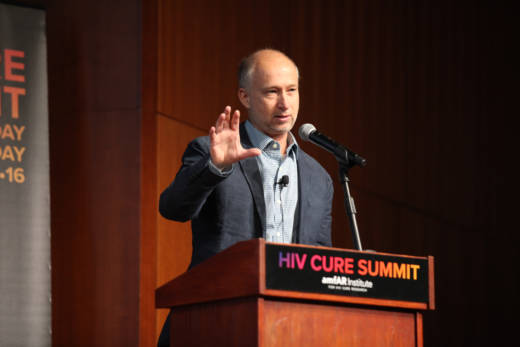"I feel a very real sense of optimism based on the evidence that we know a cure can be achieved,” said Dr. Rowena Johnston, vice-president for amfAR, in a post-summit interview with KQED. “There is a fundamental understanding we have now of the barriers between us and a cure, and how we go about to solving the problems."
In a related upcoming trial, a UCSF team will study whether an oral pill or IV drip is more effective in delivering drugs to tissue reservoirs where HIV hides. A separate observational study designed to serve as a reference for all HIV cure trials will monitor people who stop taking ARVs.
Building on a Breakthrough
The mood at the HIV Cure Summit was one of cautious optimism, in part fueled by reports from the first human shock and kill trial in Britain. In October, UK scientists conducting a 50-person study announced that the first patient to complete the treatment, a 44-year-old man given Vorinostat, ARVs and vaccines to prod the immune system, showed no detectable signs of the virus in his blood.
In short, he appeared cured. But HIV scientists worldwide quickly deemed any declaration of victory premature, cautioning that more time, as well as tissue samples, are needed to judge the treatment's efficacy. The UK trial will wrap up in 2018, and no results are expected until then.
Animal Studies Offer Hope – And a Warning
The early human findings mirror promising results from numerous lab and animal studies employing shock and kill and related therapies. In October, researchers reported that several of eight monkeys given an immune therapy plus ARVs to flush out SIV, the simian cousin to HIV, now remain free of the virus after two years. The animals continue to be monitored.
But another group has just issued a cautionary note. It may be that not all approaches to boosting the immune system will prove safe, even if effective. On Dec. 12, scientists reported brain inflammation in a study of three SIV-infected macaques given a year’s course of Vorinostat; Ingenol-B, another latency-reversing agent; and ARVs. While Vorinostat has passed human safety studies, Ingenol-B has not, said Johnston.
"Our study sounds a major cautionary note about the potential for unintended consequences of the shock-and-kill treatment strategy," stated Janice Clements, a veteran AIDS researchers at the Johns Hopkins University School of Medicine.
The Berlin Patient
At the UCSF summit, researchers stressed the difference between a full or sterilizing cure, which would constitute eradication of every last particle of HIV, and a functional cure, meaning remission. In the latter, the immune system prevents HIV from ever emerging out of dormancy.
A total cure has only been achieved in one person to date: Timothy Ray Brown, also known as The Berlin Patient. Brown was initially infected with HIV in 1995. After years of antiretroviral drugs, Brown, who also suffers from acute myeloid leukemia, underwent chemotherapy followed by two stem cell transplants from a donor whose immune cells were genetically resistant to HIV. Today, nine years later, Brown remains free of any trace of the virus in not only his bloodstream but in myriad tissue samples. He recently relocated to participate in studies in San Francisco.
“The Berlin Patient gave us the proof of concept” for an HIV cure, said Kevin Frost, amfAR CEO and the summit spokesperson. Referring to the number of people with HIV globally, he said, “Now we have to go from N-1 to N-37 million.”
The Berlin Patient's case was unique and his treatment prohibitively expensive, out of reach to millions with HIV. In the short term, a more realistic remedy than eradication of the virus is remission without antiretroviral drugs. A small minority of long-term HIV survivors, called "elite controllers," already can manage without the drugs due to their own immune systems.
If shock and kill therapies prove effective and durable, they will also prove a boon for HIV prevention. Two major studies over the last five years in thousands of couples showed that individuals on ARVs with undetectable levels of HIV were not infectious.
A number of preventive shock and kill vaccines are now being evaluated in new laboratory studies.
Needed: R&D for New Tools
Some of the buzz at the HIV Cure Summit focused on progress made with new tools to find, measure, and map latent HIV. UCSF's Peter Hunt introduced results of a new RNA-DNA probe that can simultaneously measure dormant and replicating HIV in tissue cells, as well as pinpoint the cell type.
That allows for mapping of not only the regions where reservoirs of HIV are lurking but the individual cells, explained Johnston.
“It’s an incredible advance," Johnston said. "There’s not a single group in the world who has done that.”
Another UCSF researcher, Satish Pillai, presented a novel digital-drop technology and multifluid chip test that can analyze many cells at once. Such tools are critical to assess if patients off medicines will remain HIV-free.
Looking ahead, Frost of amfAR thought a barrier to more rapid progress is a lack of pharma investment in research and diagnostics.
“In the development of antiretrovirals, the pace of research accelerated at a speed commensurate with the revenue generated," he said. "With only a few exceptions, pharma hasn’t even come to the table on cure research yet.”
HIV cure proponents also worry about possible cuts in research dollars under incoming President Donald Trump.
But such hurdles haven’t dampened their growing faith in a cure.
